Native
Hawaiian stag beetle
Family: Lucanidae Subfamily: Lucaninae Genus: Apterocyclus Species: Apterocyclus honoluluensis Waterhouse, 1871
none available
Total body length 14.0–21.0 mm (0.55–0.83 in). Body elongate-oval, thorax constricted anterioranterior:
the front or forward; opposite of posterior
to elytra; flight wings lacking. Color dull black. MandiblesMandibles:
The crushing or chewing portion of an insects mouthparts
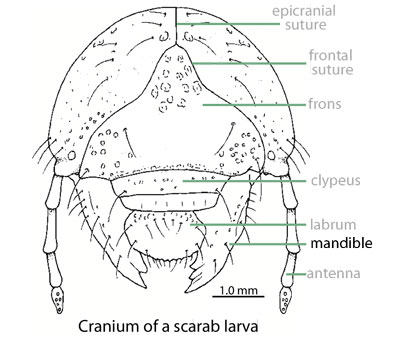 falcatefalcate:
falcatefalcate:
curved, sickle-like
; male with variable number of internal teeth; female lacking teeth; surface lacking small tubercles or granulositesgranulosites:
relating to a coarse, grainy surface texture
in both sexes. Ocular canthuscanthus:
a process extending over and sometimes dividing the eye
distinct. Front tibiatibia:
a segment of the leg articulated with the tarsus and femur
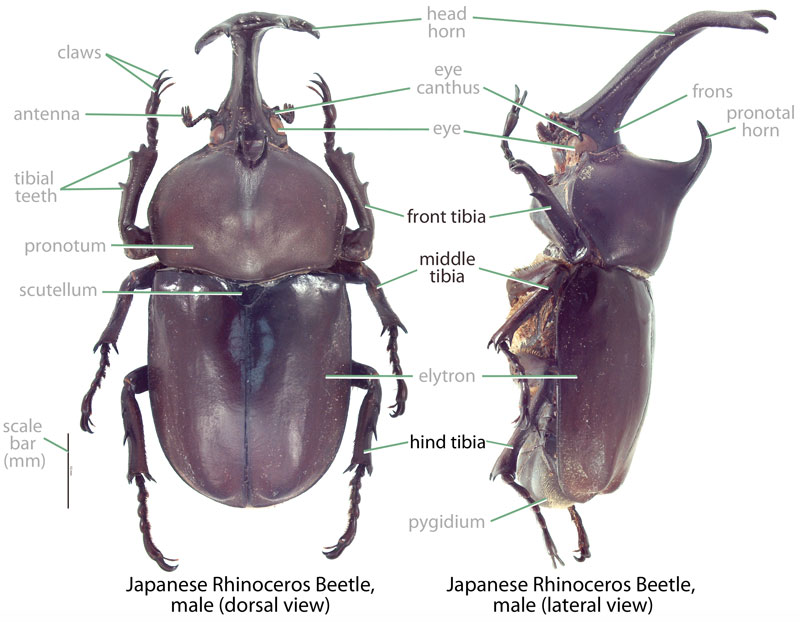 moderately expanded toward apexapex:
moderately expanded toward apexapex:
point or edge furthest from the body
; external margin with a single, apical toothtooth:
a pointed process from an appendage or margin, often in reference to the tibia
, variable number of small external teeth; apical spurspur:
movable, spine-like process, sometimes mobile, often found at or near the tibial apices
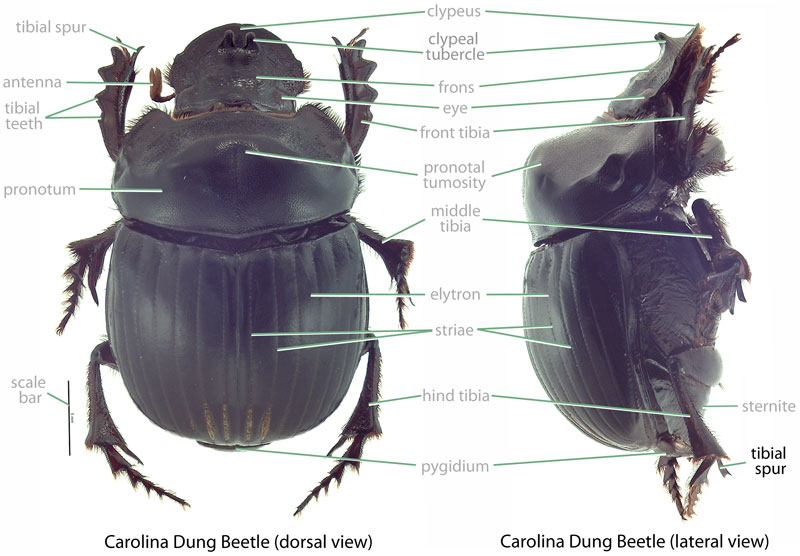 projecting forward.
projecting forward.
Undescribed. For Lucaninae (Ritcher, 1966Ritcher, 1966:
Ritcher P. 1966. White grubs and their allies: a study of North American scarabaeoid larvae. Oregon State University Monographs, Studies in Entomology 4: 1-219.): Grub C-shaped, not hump-backed, cylindrical, whitish. Mandiblemandible:
The crushing or chewing portion of an insects mouthparts
 with a ventralventral:
with a ventralventral:
of or relating to the lower surface; opposite of dorsal
process; left molar with inner margin distaddistad:
oriented away from the body or the point of articulation with body
of the molar areas with one or more teeth. Maxillary stridulatory teeth usually absent. Maxillary palpusmaxillary palpus:
multi-segmented sensory organ/appendage of the maxilla
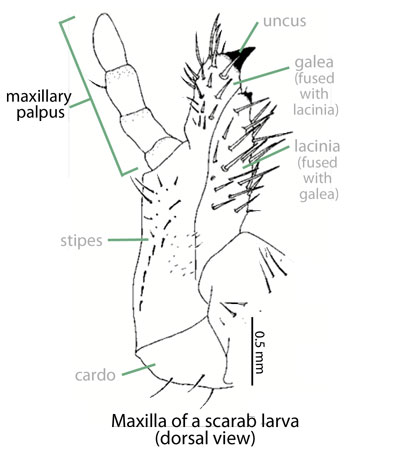 4-segmented. Thoracic spiraclesspiracles:
4-segmented. Thoracic spiraclesspiracles:
opening on the abdomen or thorax through which air enters and exits the body
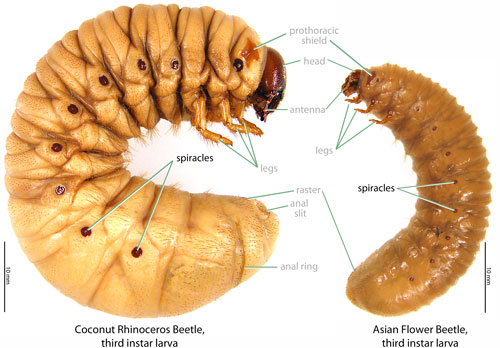 with emarginations of respiratory plates facing anteriorly. Legs not reduced in size; stridulatory organs present on front and middle legs. Middle leg with trochantertrochanter:
with emarginations of respiratory plates facing anteriorly. Legs not reduced in size; stridulatory organs present on front and middle legs. Middle leg with trochantertrochanter:
a segment of the leg articulated with the femur and coxa
with a stridulatory area consisting of a single longitudinal row of very short transversetransverse:
extending horizontally across a surface
ridges. Rasterraster:
in scarab larvae, a complex of setose, spiny, and bare areas on the ventral surface of the last abdominal segment with 2 patches of spine-like setaesetae:
with 2 patches of spine-like setaesetae:
small, hair-like structure
.
Kauai. Despite the misleading name, this species is known only from the Kōke’e State Park (Paulsen and Hawks, 2014Paulsen and Hawks, 2014:
Paulsen M and Hawks D. 2014. A review of the primary types of the Hawaiian stag beetle genus Apterocyclus Waterhouse (Coleoptera, Lucanidae, Lucaninae), with the description of a new species. ZooKeys 433: 77–88. DOI: 10.3897/zookeys.433.8022) area of Kauai.
Probably none. This species is not known to feed on living plant tissues. However, adults and larvaelarvae:
the immature form of an insect; in scarabs, also called grub or white grub; preceded by the egg stage, followed by the pupal stage
 are known to be closely associated with dead logs of the native Hawaiian koa tree (Acacia koa) (Osborn, 1920Osborn, 1920:
are known to be closely associated with dead logs of the native Hawaiian koa tree (Acacia koa) (Osborn, 1920Osborn, 1920:
Osborn, HT. 1920. A note on Apterocyclus (Coleoptera, Lucanidae). Proceedings of the Hawaiian Entomological Society 4: 375-376. full text (accessed 2015); Paulsen and Hawks, 2014Paulsen and Hawks, 2014:
Paulsen M and Hawks D. 2014. A review of the primary types of the Hawaiian stag beetle genus Apterocyclus Waterhouse (Coleoptera, Lucanidae, Lucaninae), with the description of a new species. ZooKeys 433: 77–88. DOI: 10.3897/zookeys.433.8022).
Poorly known. This species is associated with native Hawaiian koa (Acacia koa) forests at elevations above 1,200 meters. Here, flightless adults and larvaelarvae:
the immature form of an insect; in scarabs, also called grub or white grub; preceded by the egg stage, followed by the pupal stage
 burrow amongst rotting koa logs (Van Dyke, 1922Van Dyke, 1922:
burrow amongst rotting koa logs (Van Dyke, 1922Van Dyke, 1922:
Van Dyke E. 1922. A study of the lucanid Coleoptera of the Hawaiian Islands. Proceedings of the Hawaiian Entomological Society 5: 39–49. full text (accessed 2015)), with larvaelarvae:
the immature form of an insect; in scarabs, also called grub or white grub; preceded by the egg stage, followed by the pupal stage
 presumably feeding upon the decaying wood and perhaps associated fungus.
presumably feeding upon the decaying wood and perhaps associated fungus.
None. Apterocyclus species are not known to feed on living plants. This, combined with their great rarity and dependence on undisturbed native habitat, greatly limits any pest potential.
Native, rare, and local. Known only from Kauai. While the stag beetle is now rarely encountered, it appears that it was once much more abundant across its small range (Van Dyke, 1922Van Dyke, 1922:
Van Dyke E. 1922. A study of the lucanid Coleoptera of the Hawaiian Islands. Proceedings of the Hawaiian Entomological Society 5: 39–49. full text (accessed 2015); Hawaiian Entomological Society, 1915Hawaiian Entomological Society, 1915:
Anonymous. 1915. Minutes of the March 4 th , 1915 meeting. Proceedings of the Hawaiian Entomological Society 3: 113–114. full text (accessed 2015)). The decline of the native Hawaiian stag beetles is likely due to a combination of habitat loss and heavy predation from non-native rodent species (Howden, 2008Howden, 2008:
Howden H. 2008. In past years - XIII 1970–1974. Scarabs Newsletter 30: 15–21.).
Not established or recorded. There are no records of this species from Guam.
All Apterocyclus species are flightless, rare, and dependent upon vanishing native Hawaiian habitat. As such, members of this genus are unlikely to spread beyond their small natural ranges.
Apterocyclus honoluluensis is one of five Apterocyclus known from Kauai. It can be separated from other native stag beetles by examination of the male mandiblesmandibles:
The crushing or chewing portion of an insects mouthparts
 (A. honoluluensis with short, falcatefalcate:
(A. honoluluensis with short, falcatefalcate:
curved, sickle-like
mandibles; surface lacking small tubercles or granulositesgranulosites:
relating to a coarse, grainy surface texture
versus A. palmatus with tusk-like mandiblesmandibles:
The crushing or chewing portion of an insects mouthparts
 , A. kawaii with mandiblesmandibles:
, A. kawaii with mandiblesmandibles:
The crushing or chewing portion of an insects mouthparts
 short, falcatefalcate:
short, falcatefalcate:
curved, sickle-like
; surface with numerous small tubercles or granulosites), ocular canthuscanthus:
a process extending over and sometimes dividing the eye
(A. honoluluensis with distinct ocular canthuscanthus:
a process extending over and sometimes dividing the eye
versus all other Apterocyclus species with canthuscanthus:
a process extending over and sometimes dividing the eye
indistinct), and front tibiatibia:
a segment of the leg articulated with the tarsus and femur
 (A. honoluluensis tibiatibia:
(A. honoluluensis tibiatibia:
a segment of the leg articulated with the tarsus and femur
 moderately expanded toward apexapex:
moderately expanded toward apexapex:
point or edge furthest from the body
; external margin with a single, apical toothtooth:
a pointed process from an appendage or margin, often in reference to the tibia
, variable number of small external teeth; apical spurspur:
movable, spine-like process, sometimes mobile, often found at or near the tibial apices
 projecting forward versus A. palmatus with front tibiatibia:
projecting forward versus A. palmatus with front tibiatibia:
a segment of the leg articulated with the tarsus and femur
 expanded toward apexapex:
expanded toward apexapex:
point or edge furthest from the body
with apical ¼ greatly produced; with 1 large apical toothtooth:
a pointed process from an appendage or margin, often in reference to the tibia
and 1 large external toothtooth:
a pointed process from an appendage or margin, often in reference to the tibia
; apical spurspur:
movable, spine-like process, sometimes mobile, often found at or near the tibial apices
 enlarged and projecting medially, A. kawaiiwith front tibiatibia:
enlarged and projecting medially, A. kawaiiwith front tibiatibia:
a segment of the leg articulated with the tarsus and femur
 gradually expanded toward a greatly broadened apexapex:
gradually expanded toward a greatly broadened apexapex:
point or edge furthest from the body
; with 1 broad apical toothtooth:
a pointed process from an appendage or margin, often in reference to the tibia
and 1 weak external toothtooth:
a pointed process from an appendage or margin, often in reference to the tibia
; apical spurspur:
movable, spine-like process, sometimes mobile, often found at or near the tibial apices
 peg-like, A. munroi tibiatibia:
peg-like, A. munroi tibiatibia:
a segment of the leg articulated with the tarsus and femur
 moderately expanded toward apexapex:
moderately expanded toward apexapex:
point or edge furthest from the body
; external margin with 2 teeth at apexapex:
point or edge furthest from the body
(appearing somewhat bidentatebidentate:
a surface that is sharply notched, usually resulting in two tooth-like protrusions on each side of the notch
); with 2-5 small external teeth; apical spurspur:
movable, spine-like process, sometimes mobile, often found at or near the tibial apices
 thin and projecting forward, A. waterhouseiwith front tibiatibia:
thin and projecting forward, A. waterhouseiwith front tibiatibia:
a segment of the leg articulated with the tarsus and femur
 enlarged from base; apical toothtooth:
enlarged from base; apical toothtooth:
a pointed process from an appendage or margin, often in reference to the tibia
small or lacking, numerous small external teeth; apical spurspur:
movable, spine-like process, sometimes mobile, often found at or near the tibial apices
 small and projecting forward).
small and projecting forward).
Apterocyclus deceptor Sharp, Apterocyclus feminalis Sharp, Apterocyclus varians Sharp
Report your observation of this rare and native Hawaiian species at our iNaturalist project.